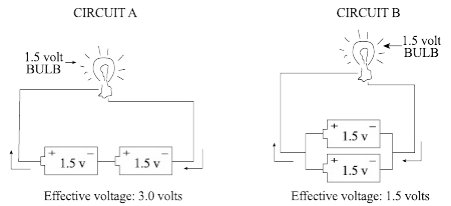Each light bulb represented above is part of a battery-charged electrical circuit. The light bulb acts as a resistor, which means that it uses up electricity that otherwise would be passed along the circuit toward the negative terminal of the battery pack. The end-to-end battery arrangement in circuit A combines battery voltages, whereas the parallel arrangement in circuit B does not. If the hourly use of the light bulb is the same for both circuits, what can you infer from the two diagrams?

Explanation
In neither circuit is any current returned to the batteries to recharge them. Since the battery arrangement in circuit B generates only half the voltage as the arrangement in circuit A, the batteries in circuit B will last longer.
Visit our website for other GED topics now!


